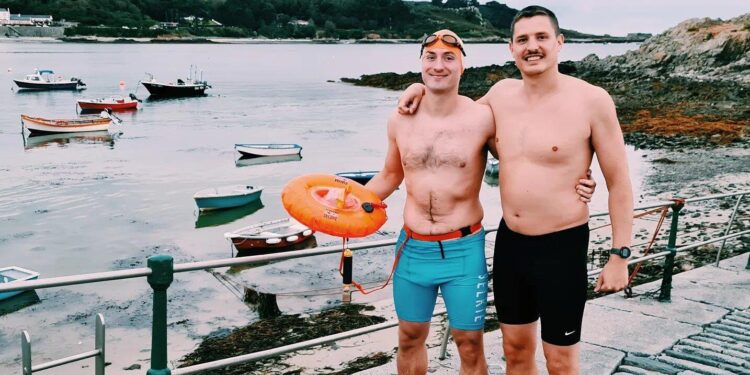Guernsey’s sea swimming community has issued a strong appeal to the public to carefully evaluate weather and sea conditions before venturing into the water. Following a series of incidents and changing maritime environments, local swimmers emphasized the importance of safety precautions to prevent accidents. Authorities and experienced sea swimmers alike are urging individuals to remain vigilant and prioritize caution when enjoying the island’s coastal waters.
Guernsey Sea Swimmers Highlight Risks of Unpredictable Coastal Conditions
Local sea swimmers in Guernsey have issued a stern warning to beachgoers about the often deceptive nature of coastal conditions around the island. Despite the inviting appearance of calm waters on sunny days, the sea can quickly change, presenting hidden dangers such as strong currents, sudden temperature drops, and underwater hazards. Swimmers emphasise the need for everyone to conduct thorough assessments before entering the water, rather than relying solely on visual cues or weather forecasts.
Key safety measures recommended by experienced swimmers include:
- Checking tide times – to avoid getting caught out by rapidly rising or falling tides.
- Observing the water’s surface – signs of rip currents and unusual wave patterns can indicate risk areas.
- Swimming with a buddy – never entering the water alone, especially in unfamiliar locations.
- Using appropriate gear – wetsuits, flotation aids, and visibility accessories can improve safety.
| Hazard | Description | Recommended Action |
|---|---|---|
| Rip Currents | Strong, narrow currents pulling swimmers offshore. | Swim parallel to shore to escape. |
| Cold Water Shock | Sudden drop in water temperature causing muscle cramps. | Wear wetsuits and acclimatise slowly. |
| Underwater Rocks | Hidden jagged rocks lurking beneath the surface. | Scout swimming areas and avoid unknown spots. |
Experts Advise Thorough Weather and Tide Checks Before Entering the Water
Local sea swimming experts emphasize the critical importance of reviewing weather forecasts and tide schedules before venturing into Guernsey’s waters. Sudden changes in wind direction or speed, as well as shifting currents, can quickly alter swimming conditions, posing risks even to experienced swimmers. Authorities remind the public that understanding the dynamic nature of coastal conditions is essential for safety and enjoyment.
Key guidelines shared by specialists include:
- Consult multiple weather sources to get a comprehensive view of upcoming changes.
- Focus on tide timings to avoid strong rip currents and low water hazards.
- Avoid swimming during or after heavy rainfall which can reduce water quality and visibility.
- Check local advisories for any warnings or recent incidents in popular swim spots.
| Factor | Why It Matters | Recommended Actions |
|---|---|---|
| Tides | Affects water depth and current speed | Check tide tables; swim at safe tidal states |
| Wind | Can create waves and change water temperature | Monitor forecasts; avoid strong winds |
| Visibility | Impacts swimmer safety and orientation | Avoid cloudy or rainy days if possible |
| Water Quality | Important for health and preventing infections | Check local water quality reports |
Safety Precautions Recommended for All Levels of Sea Swimmers in Guernsey
Before plunging into Guernsey’s waters, swimmers of every skill level should take the time to carefully evaluate weather and tide conditions. The island’s coastal currents can shift rapidly, turning a seemingly calm swim into a hazardous situation. Locals emphasize the importance of checking official tide times and weather forecasts to avoid unexpectedly strong currents or sudden temperature drops. Wearing a brightly colored swim cap and using a tow float can increase visibility and provide additional safety, especially in areas where boats or jet skis may be present.
Swimmers are also advised to never enter the water alone. Buddy systems and informing someone onshore about your estimated swim route and duration can prove lifesaving. For those new to sea swimming or unfamiliar with Guernsey’s coastlines, joining local swimming groups is recommended, as they provide valuable firsthand knowledge and support. Below is a quick reference table outlining essential equipment and safety measures commonly endorsed by experienced sea swimmers:
| Essential Item | Purpose |
|---|---|
| Bright Swim Cap | Improves visibility to boats and lifeguards |
| Neoprene Wetsuit | Maintains body warmth and improves buoyancy |
| Float Tow | Provides rest point and aids in visibility |
| Waterproof Whistle | Alerts others in case of emergency |
To Conclude
As the popularity of sea swimming continues to grow across Guernsey, local swimmers and safety advocates emphasize the importance of vigilance and preparation. With the island’s waters presenting variable conditions, experts urge all swimmers-whether novices or veterans-to thoroughly assess weather, tides, and sea state before entering the water. By promoting awareness and responsible practices, the community hopes to ensure that enjoying Guernsey’s coastal waters remains a safe and rewarding experience for all.















